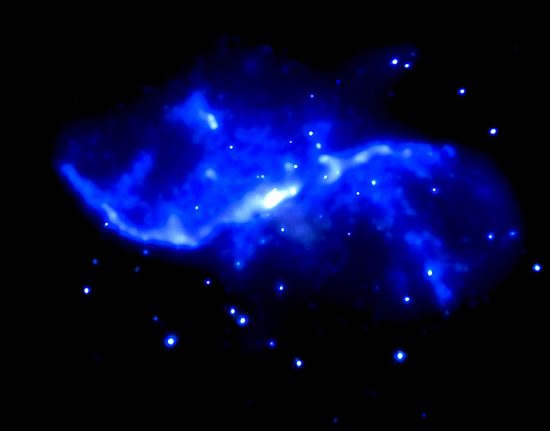
NGC 4258 in X-ray wavelengths. Credit: NASA/CXC/Caltech/P.Ogle et al.
Apr 10, 2017
Enigmatic galactic structures.
NGC 4258 is called “the weirdo galaxy” in a recent press release. Two arms of its spiral structure are not in the plane of rotation; instead, they rise from the galaxy’s core. The additional arms exist within the path of energetic particles ejected from the galaxy’s central region, and are tipped thirty degrees above and below its rotational plane. However, no other galaxy has two active jets occurring at the same time in different alignments. Astronomers once thought that a black hole was responsible for the anomalous structures. Now, with these new observations, they believe it is shock waves heating gas and dust that generate radiation strong enough for the Chandra X-ray Telescope to see.
There are many basic unanswered questions about stars: what force powers their electromagnetic fields and defines their shapes and strength?
Extrasolar magnetic field detection is based on George Ellery Hale’s plots of the Sun’s magnetic field using the Zeeman effect. In the presence of a magnetic field, elements produce spectral lines that split and occupy different spectrographic positions than they normally do. Those changes in position are called the Zeeman effect. Although electromagnetic fields can be mapped, their origins, their evolution and their internal structures are unsolved mysteries.
NGC 4258 is one of the original examples that convinced astronomers that almost all galaxies contain a central supermassive black hole. They assumed that conclusion because there are luminous “blobs” orbiting the center of the galaxy at over 1000 kilometers per second. Since they are moving so fast over such a short (in astronomical terms) distance, there “must be” a gravitational force millions of times greater than any single star holding them to a course. Therefore, the energetic particles are “shot out” like paint droplets from a spinning turntable. Kinetic energy derived from a powerful gravity field, in other words.
It is not surprising that the magnetic field contours indicating anomalous arms remain locked inside gravitational theories consensus viewpoints: there are no electrical entities to provide a source for that magnetism. It is a well-established principle of physics that magnetic fields can not exist without electricity to generate them. Instead, ideas like “gas ejection” and “ordered magnetic fields arising from random ones” are discussed. No electromagnetism, no electric fields, and no motor-generator effects are included in their calculations.
Modern astronomers think that magnetic fields are “primordial” fragments left over from the Big Bang. They rely on that conclusion to explain how the structures that make up the Universe were formed. Rather, when charged particles accelerate in the same direction, electric fields get stronger. That idea is familiar to electrical engineers, but when astronomers find moving charges in space they are mystified and refer to them as “winds,” or “shock waves”.
For charged particles to move, they must move in a circuit. Energetic events cannot be explained by appealing to local conditions—an entire circuit must be considered. For that reason, Electric Universe theory emphasizes connectivity with an electrically active network of “transmission lines” composed of Birkeland current filaments.
Filaments can throw off plasmas that accelerate to near light-speed. Jets from opposite poles of a galaxy end in energetic clouds emitting X-ray frequencies. These phenomena are based in plasma science and not gas kinetics, gravity, or particle physics. Astrophysicists see magnetic fields but not the underlying electricity, so they are at a loss to explain them.
In 1981, Hannes Alfvén said that galaxies act like a homopolar motor/generator. A homopolar motor is driven by magnetic fields induced in a circular conducting plate. The plate is mounted between the poles of an electromagnet, causing it to spin at a rate proportional to the input current. Electrical energy is orders of magnitude more powerful than gravity. Birkeland currents attract one another over distance in a linear relationship, so Birkeland currents are the most powerful long-range attractors in the Universe, so it is electric currents in dusty plasmas that sustain electromagnetic fields detected in stars and galaxies.
Stephen Smith












